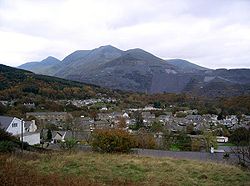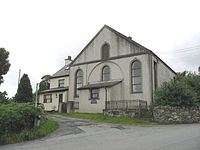Bethesda, Caernarfonshire
| Bethesda | |
| Caernarfonshire | |
|---|---|
 Bethesda and the quarry | |
| Location | |
| Grid reference: | SH624667 |
| Location: | 53°10’46"N, 4°3’37"W |
| Data | |
| Population: | 4,327 (2001) |
| Post town: | Bangor |
| Postcode: | LL57 |
| Dialling code: | 01248 |
| Local Government | |
| Council: | Gwynedd |
| Parliamentary constituency: |
Arfon |
Bethesda is a small town in Caernarfonshire, on the banks of the River Ogwen and on the A5 trunk road on the edge of Snowdonia. It is colloquially called Pesda by the locals.
The village's name is taken from the Bethesda Chapel, a chapel of the Revival in the nineteenth century. The chapel name of course was inspired by the Pool of Bethesda in Jerusalem, where Our Lord healed a crippled man. (It is Hebrew for "House of Grace", which is appropriate to a keen chapel.)
The town
The town grew around the slate and stone quarrying industry, the largest of the local quarries being the Penrhyn Quarry. At its peak, it was exporting its purple slate all over the world, and in so doing it gained a reputation for being the world's best. The town was the site of a famous three-year strike led by the North Wales Quarrymen's Union from 1900. This led to the creation of the nearby village of Tregarth, built by the quarry owners, which housed the families of the workers who did not strike.
Most of the town is to the east and north east of the A5 road with housing packed onto the hill-side in irregular rows, for the trunk road marked the boundary between Lord Penrhyn's estate, and the freehold land. This can still be seen in the layout of the current high street where all the public houses are only found on one side of the road.
During its heyday, the population of Bethesda peaked at 10,000 people, but it was recorded as 4,327 souls at the 2001 census. A small number of manufacturing businesses remain in the town, but the majority of businesses are in the low-paid service sector and hospitality industry and the higher earners commute to towns along the coast, to Bangor or even as far as Cheshire.
Architecture
The architecture and layout of the town is largely utilitarian. Most of the buildings are built in stone with slate roofs. Some are built wholly of slate blocks although such buildings tend to suffer from damp and structural slippage because the very flat and smooth surfaces of slate do not bind well to mortar.
The town has 40 Grade II listed buildings, including three pubs and the substantial and imposing Calvinistic Methodist Jerusalem Chapel.
The upper parts of Carneddi, Cilfodan and Tan y Foel owe more to stone quarrying on the nearby hills rather than slate quarrying that supported the lower end of the town. At the eastern limits, the town is bounded by the rising land of the Carneddau mountains, which form some of the more remote landscapes of Snowdonia. Much of Bethesda was once discrete villages such as Gerlan, Rachub and Braichmelyn and their names are retained as districts of the town.
Chapels

Bethesda is noted for both the number of chapels (mostly dating from the 1904-1905 Welsh Revival) and pubs in the town. The town was named after the Bethesda Chapel, which was recently converted into residential flats.
Public houses
Considered by some infamous for its pubs, there are no fewer than ten public establishments that serve alcohol in the Bethesda area (excluding Tregarth). It is noted throughout the surrounding area that the busiest night in Bethesda is Sunday, not the typical Saturdays or Fridays. One of the High Street pubs, the Douglas Arms, was named after the family which owned the nearby Penrhyn Quarry. Other include the Tŷ Isaf, The Bull, The Kings Head, Y Sior, The Victoria Arms, and the Llangollen.
Language and culture
Welsh is the dominant language of the town, and can be seen and heard in most settings. According to the 2001 census, 77% of the residents were Welsh-speaking.
The S4C series Amdani! was based on a fictitious women's rugby team in Bethesda, and many of the location shots were filmed in the area. The series was based on the novel of the same name, by Bethan Gwanas, who lived in the town at the time.